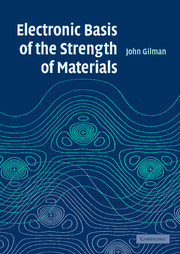Book contents
- Frontmatter
- Contents
- Preface
- Section I Introduction
- Section II Elements of solid mechanics
- Section III Elements of electron mechanics
- 5 Properties of electrons
- 6 Quantum states
- 7 Periodic patterns of electrons
- 8 Heisenberg's Principle
- Section IV Elastic stiffness
- Section V Plastic strength
- Section VI Fracture resistance
- Index
- References
8 - Heisenberg's Principle
Published online by Cambridge University Press: 14 August 2009
- Frontmatter
- Contents
- Preface
- Section I Introduction
- Section II Elements of solid mechanics
- Section III Elements of electron mechanics
- 5 Properties of electrons
- 6 Quantum states
- 7 Periodic patterns of electrons
- 8 Heisenberg's Principle
- Section IV Elastic stiffness
- Section V Plastic strength
- Section VI Fracture resistance
- Index
- References
Summary
Textbooks often emphasize the philosophical aspects of Heisenberg's Principle calling it “The Uncertainty Principle”. However, as a physical principle there is nothing uncertain about it. In its “exact” form it is a useful relationship between physical parameters. It is an expression of the fact that particles of matter behave simultaneously in two modes: one that is particle like, and the other that is wave like. These two modes are intimately connected, and it is this connection that is expressed in the Heisenberg Principle, and more generally in quantum mechanics including Schrödinger's equation (Atkins and Friedman, 1997). From this viewpoint, the principle can be used to deduce some of the properties of atoms and molecules in a simple way. This method of analysis is quantitative, but it is limited to cases that involve only a single coordinate that is given in advance (Born, 1989).
The method has been extended somewhat by Simons and Bloch (1973) to cover some cases involving the angular momentum quantum number. It is a rudimentary form of density functional theory. In a somewhat different form than the one used here, it has been applied to molecules by Parr and his collaborators (Borkman and Parr, 1968).
Physical properties can never be measured exactly. Errors, however small, are always present in a measurement procedure. Therefore, measured values of variables are average values derived from a distribution of individual measurements.
- Type
- Chapter
- Information
- Electronic Basis of the Strength of Materials , pp. 56 - 62Publisher: Cambridge University PressPrint publication year: 2003



